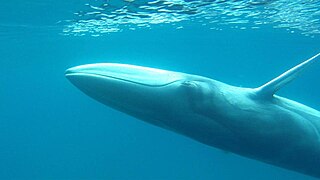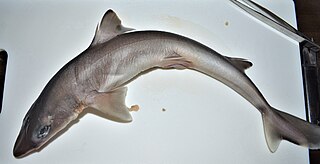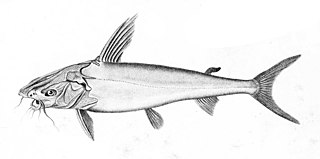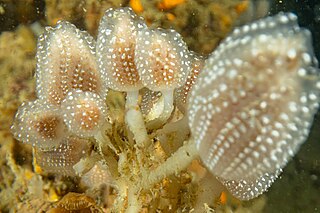
Omura's whale or the dwarf fin whale is a species of rorqual about which very little is known. Before its formal description, it was referred to as a small, dwarf or pygmy form of Bryde's whale by various sources. The common name and specific epithet commemorate Japanese cetologist Hideo Omura.
The Arafura Games is a multi-sport event where athletes with a disability compete in the same program as able-bodied athletes. Competitors from around the world compete in the week-long games held every 2 years in Darwin, Northern Territory, Australia.

The Arafura Sea lies west of the Pacific Ocean, overlying the continental shelf between Australia and Western New Guinea, which is the Indonesian part of the Island of New Guinea.

Pyura is a large genus of sessile ascidians that live in coastal waters at depths of up to 80 m (260 feet). Like all ascidians, Pyura are filter feeders. A few species, including Pyura chilensis are commercially fished.

Geologically, the Sahul Shelf is a part of the continental shelf of the Australian continent, lying off the northwest coast of mainland Australia.

The Japanese spurdog is a dogfish, a member of the family Squalidae. It is found in the western Pacific Ocean – southeastern Japan and the East China Sea, including the Republic of Korea, the Philippines, and the Arafura Sea. It occurs in temperate and tropical waters along the continental shelf and slopes and primarily feeds on teleost fish and squid. It is caught as bycatch in commercial fishing, which has caused populations to decline.

Clavelina is genus of sea squirts, containing the following species:

Amoria is a taxonomic genus of medium-sized predatory marine gastropod in the family Volutidae.

The Central Indo-Pacific is a biogeographic region of Earth's seas, comprising the tropical waters of the western Pacific Ocean, the eastern Indian Ocean, and the connecting seas.

The East Indian Archipelago is an area designated by the International Hydrographic Organization (IHO). It encompasses twelve seas, two gulfs, and one strait in the East Indies.

The Jenkins' whipray is a species of stingray in the family Dasyatidae, with a wide distribution in the Indo-Pacific region from South Africa to the Malay Archipelago to northern Australia. This large species grows to 1.5 m (4.9 ft) across and has a broad, diamond-shaped pectoral fin disc and a whip-like tail without fin folds. It has a band of heart-shaped dermal denticles running from between the eyes to the tail on its upper surface, along with a characteristic row of large spear-like thorns along the midline. It is uniform yellowish brown above, becoming grayish on the tail past the stinging spine, and white below; there is apparently a spotted color variant that had previously been described as a different species, the dragon stingray.
The Cook's swellshark is a little-known species of catshark, belonging to the family Scyliorhinidae. This shark is found in the Arafura Sea at a depth of 223–300 m (732–984 ft). It is a stocky-bodied shark with a short, broad head and a large mouth, and can be identified by the eight dark, pale-edged saddles along its grayish brown body and tail. The maximum known length of this species is 30 cm (12 in). Like other swellsharks, it can inflate itself with water or air when threatened.
Ancillista ngampitchae is a species of sea snail, a marine gastropod mollusk in the family Ancillariidae.

Tonna oentoengi is a species of large sea snail, a marine gastropod mollusk in the family Tonnidae, the tun shells.

Netuma is a genus of sea catfishes found in the Indian Ocean and the western Pacific Ocean where it occurs in marine, brackish and fresh waters from the coasts of Africa to Australia to China. There are currently four recognized species in this genus.

Sagittidae is a family of sagittoideans in the order Aphragmophora.
Spadellidae is a family of sagittoideans in the order Phragmophora. Spadellidae prey on plankton and commonly reside in the epipelagic zone of the ocean.
Aipysurus tenuis, also known as the Arafura sea snake, Mjoberg's sea snake or brown-lined sea snake, is a species of venomous snake in the family Elapidae that is native to Australia. The specific epithet tenuis ("slender") refers to the snake's appearance.

Sycozoa pulchra, is a sea squirt in the family Holozoidae, first described by William Abbott Herdman in 1886 as Colella pulchra. The taxonomic decision which determined the name, Sycozoa pulchra, and the species' synonymy was given by Patricia Kott in 1990.

Sycozoa sigillinoides is a species of sea squirt in the family Holozoidae, first described by René Lesson in 1932.














